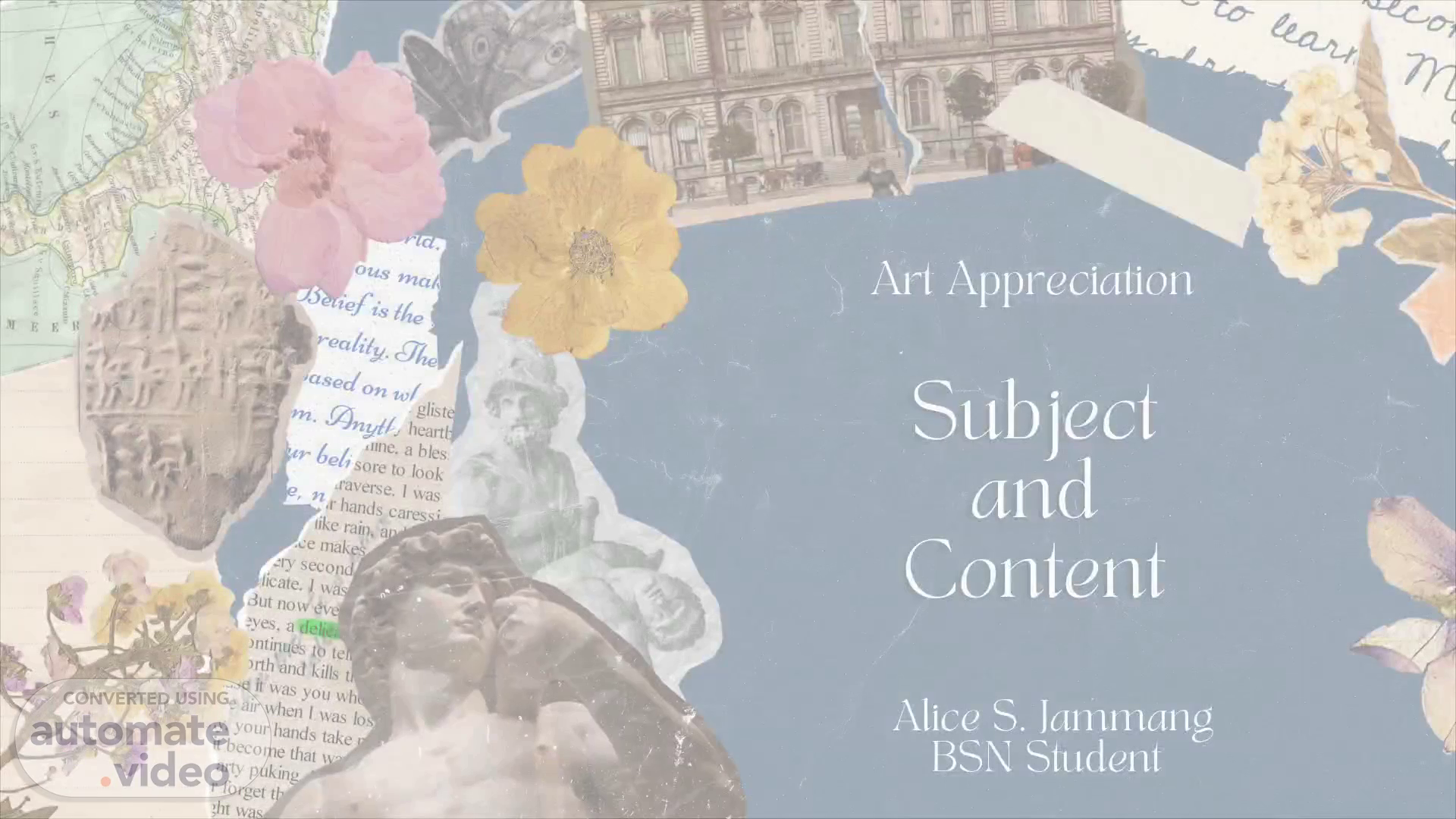
57D02DA5-BA2B-4C11-B2B5-654963FEC4CE
Scene 1 (0s)
5iuiJ% ous tefis (he pea /z7y. on to/ staverse. I was gr hands xares like .ce makg Cty secood •licate. -yes, ade »ntinqés te you wh '+flr when I was los say,' your hands take it become that any pukin r forget t Art Appreciation Subject and Content Alice S. Jammang BSN Student.
Scene 2 (13s)
Introduction: the topic of subject and content in ar . Art has been a part of human culture and society for thousands of years, and it allows us to express ourselves in unique and creative ways. But to truly appreciate and understand art, we must understand the significance of its subject and content..
Scene 3 (29s)
Head of a Woman, Mougins Pablo Picasso (1962) Looking at the combination of lines, shapes, and colors of the sculpture will point to a head of a woman Even with the abstraction of the image, this work is arguably representational art..
Scene 4 (42s)
Discobolus Myron (Roman, 2nd Century AD) ).
Scene 5 (49s)
r tinie th&V- '*It was a mess bu' mm became so intere ced in White walls of y 'ur roo k)tion, the whitef th humor seem' like the emost, I fall ft tand flus' and I curse in •mind to.
Scene 6 (1m 0s)
Factual meaning o The most rudimentary level of meaning for it may be extracted from the identifiable Or recognizable forms in the artwork and understanding how these elements relate to one another..
Scene 7 (1m 12s)
Conventional meaning o Pertains to the acknowledged interpretation of the artwork using motifs, signs, and symbols and other cypheys as bases of its meaning. o These conventions are established through time, strehgthened by recurrent use and wide acceptance by its viewers or audience and scholars who study them..
Scene 8 (1m 26s)
Subjective meaning • When subjectivities are consulted, a variety of meanings may arise when a oarticular work of art is read. • These meanings stem from the viewer's or audience's Circumstances that come into play when engaging with art (what we know what we learned, what we experienced; what values we stand for) o Meaning may not be singular, rather, multiple and varied.
Scene 9 (1m 44s)
by. It cc ing you. it is, 02 03 Learning Objectives Differentiate representional art and nonrepresentional art Discuss the difference between an artwork's subject and its content; Identify the subiect matter and specific examples of art; and numerate the sources ofthe subiects of Some of the most recognizable works of art in Ohilippine art history. ficat :yes, ,ontil yol it bec r fol.
Scene 10 (2m 1s)
ART Art forms that do not make a reference to the real world, whether it is a person, place, thing, or even a particular eveni. It is stripped down to visual elements, such as >hapes, lines, and colors that are employed to translate a particular feeling, emotion, and even concept..
Scene 11 (2m 17s)
NON-REPRESENTATIONAL AR AND ABSTRACT ART Nurnber IA Jackson Yohock ( 194b) Is non-representational art the same with abstract art? There is no clear-cut divide, rather, they exist in a spectrum..
Scene 12 (2m 28s)
SOURCES AND KINDS OF SUBJECT For non-representational art, a higher, level of perceptiveness .and insightjnight be required Tully grasped the feeling, emotion, or conce behind the work. For representational art, it is easier to infer the subject matter because from the figures depicted in the artwork, there is already a suggestion as to its implication..
Scene 13 (2m 45s)
Sources of Subject Nature History • Greek and Roman mythology Judeo-Christian tradition o Sacred oriental texts Other works of art.
Scene 14 (2m 53s)
A Cockchafer, Beetle, Woodlice and Other Insect, with a Sprig of Auricula Jan van Kessel (early 1960s).
Scene 15 (3m 2s)
Young Women Fabian de Ia Rosa 1902.
Scene 16 (3m 9s)
Sistine Chapel Mic e anae o (1508-1512).
Scene 17 (3m 15s)
El Tres de Mayo Gova (1814).
Scene 18 (3m 22s)
CONTENT IN ART o The meaning or message that is expressed or communicated by the artwork. •An understanding the content of art, it is impo+tant to note !hat there are various levels of meaning:.
Scene 20 (3m 39s)
Analysis o Subject: biblical art •Factual meaning: Creation Story (creation of man) o Conventional meaning: man was created in the image likeness of God o Subjective meaning: endowment of intellect to man fro GO d.
Scene 21 (3m 51s)
m3 Basic Component of art work Subject - the visual focus or the image that may be extracted from examining the artwork; the "what" Content - the meaning that is communicated by the artist or the artwork; the "why" Form - pthe development and configuration of the art work - how the elements and the medium or material are put together; the "how".